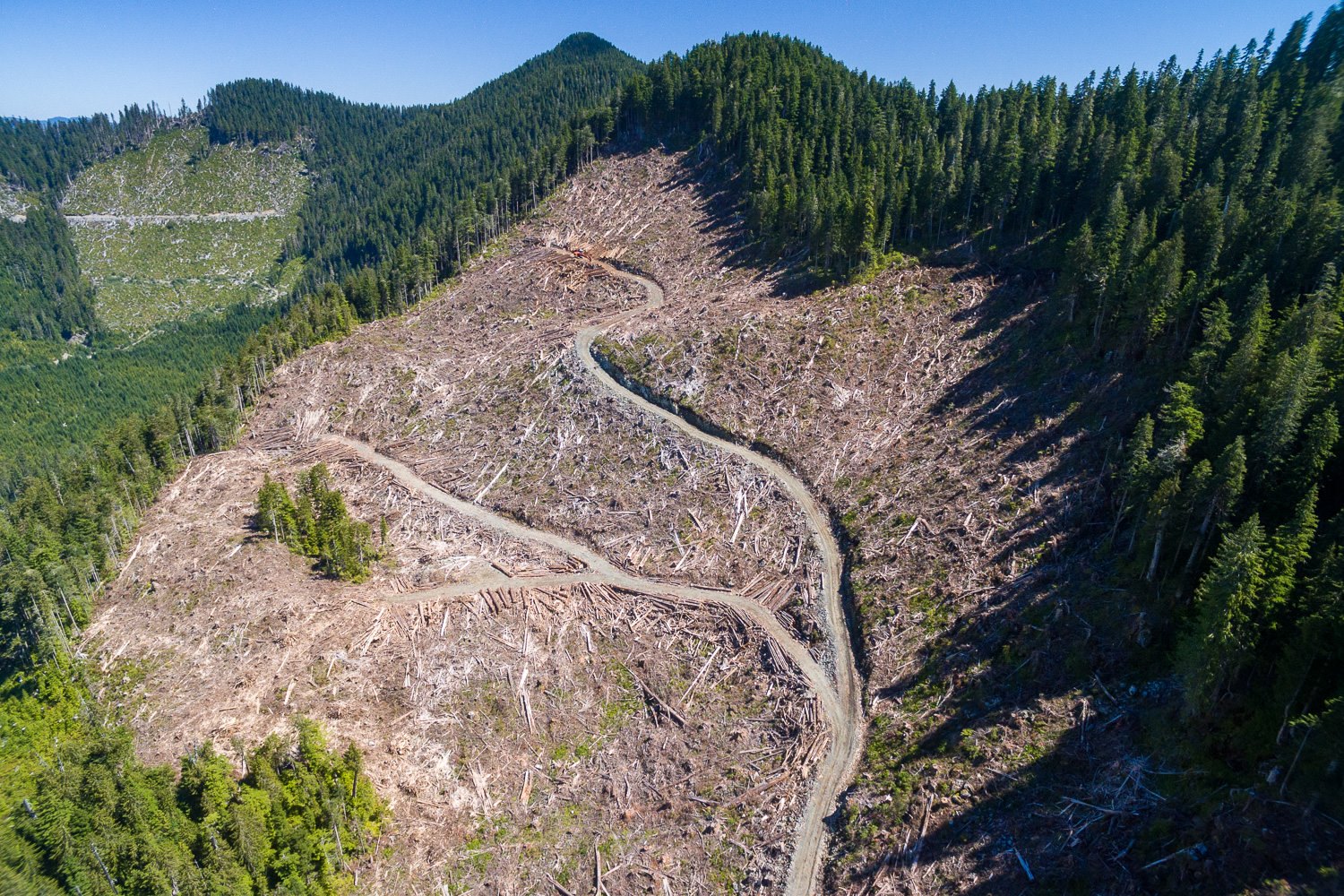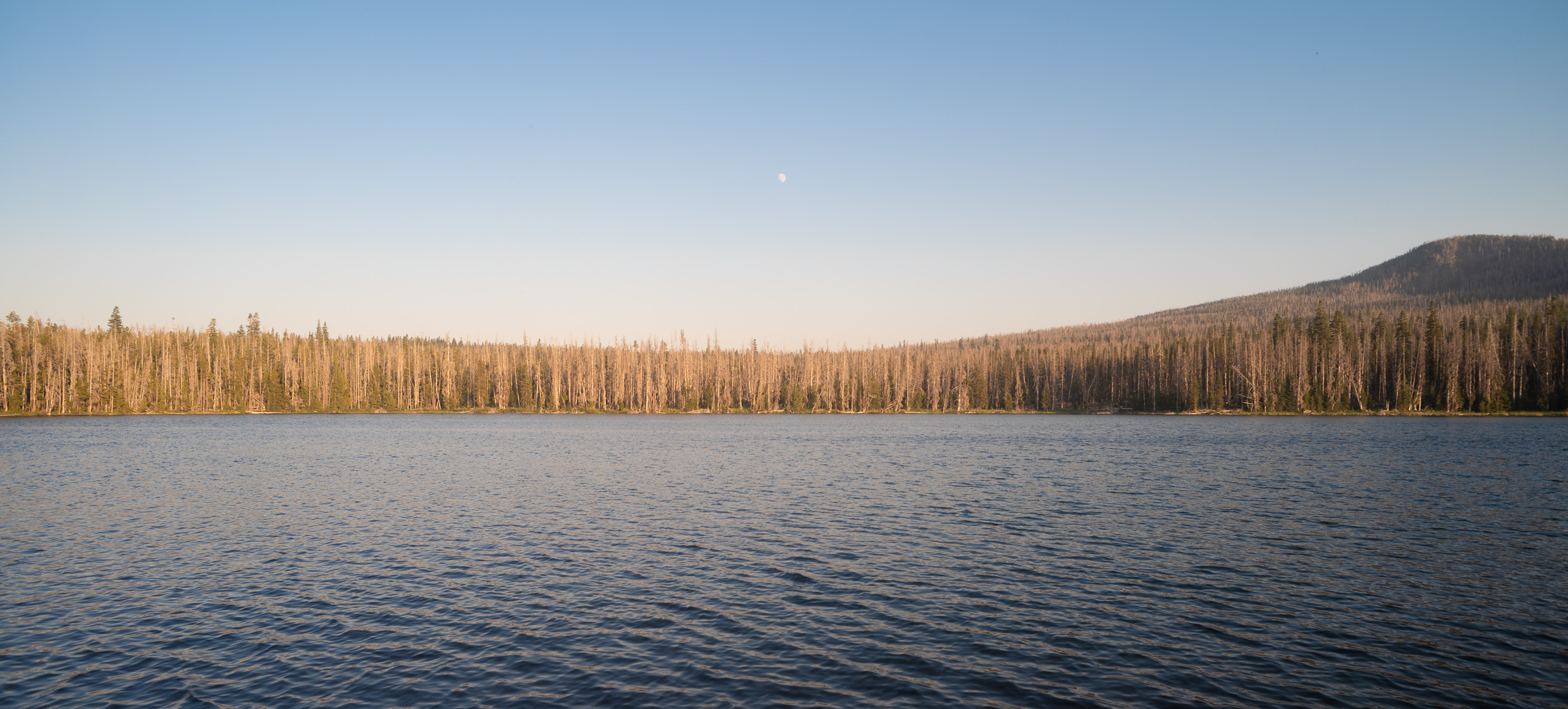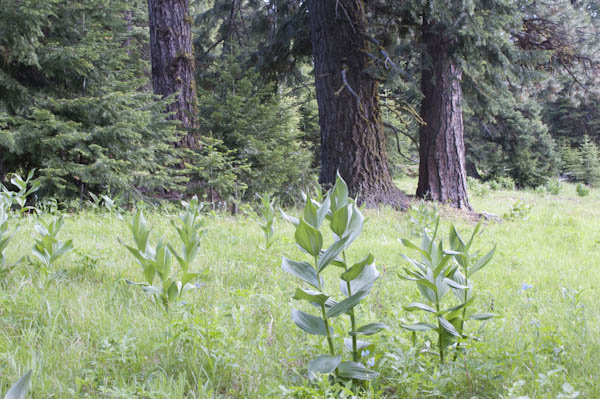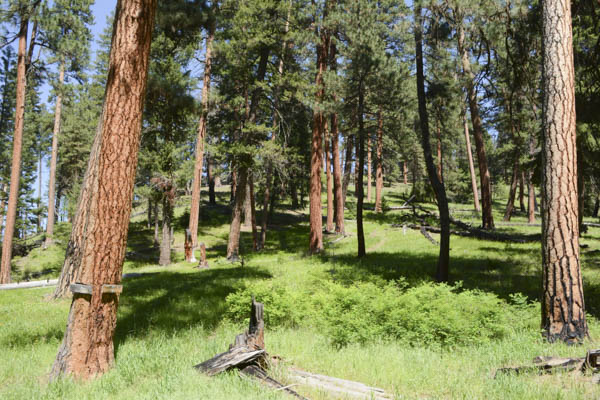
by DGR News Service | Aug 25, 2020 | Biodiversity & Habitat Destruction, Direct Action
A third blockade has started to stop the logging of near the headwaters of Fairy Creek. To learn more about the blockade in Fairy Creek, read the media release by the organizers of the blockade, and listen to interviews with Joshua Wright here and here. Access the official Facebook page here.
Two weeks into a campaign to halt logging of ancient rainforests in the last intact watershed of the San Juan River system, activists have set up a third blockade on unceded Pacheedaht territory!
Grassroots forest defenders from across Vancouver Island have successfully prevented Teal Jones Group from blasting logging roads into the unlogged headwaters of the Fairy Creek watershed for the past two weeks.
The first blockade was established on Monday, August 10th, where the new roads were about to crest a ridge into the west side of the watershed. The blockaders successfully turned away the road builders early that morning. Teal Jones removed their road building equipment on Tuesday, August 11th, and the blockade has remained in place continuously since then.
On August 17th, in light of government inaction to meet the blockaders demands, a second blockade was established just to the east of the Fairy Creek watershed, preventing Teal Jones from building roads which have been approved for construction into that side of the rainforest, located on unceded Pacheedaht Territory.
And on the evening of August 23rd, a third blockade was established. The third blockade is located on a logging road on Edinburgh mountain (also unceded Pacheedaht Territory). With the exception of Eden Grove on Edinburgh mountain, contiguous old-growth corridors have been severed between the rich valley bottom and the protected upper reaches. The infamous Big Lonely Doug stands in stark contrast to clear cut in a cutblock on Edinburgh, the sole remaining giant fir in the cut. Lonely Doug has become an internationally recognized symbol for BC’s devastating logging practices. Just up the mountain, logging is ongoing. This is what the newest blockade will stop.

Photo shows Teal Jones old-growth logging operations adjacent to Fairy Creek. Photo by Ancient Forest Alliance.
This new blockade also obstructs old growth logging already in progress east of Fairy Creek.
This stretch of ancient forest is contiguous with the intact old growth forest within the Fairy Creek watershed and contains high value valley bottom old growth forest that would be fully eradicated if the logging was allowed to continue. A massive, ancient cedar recently felled by Teal Jones in one of the old growth cut blocks now being blockaded:
“If anyone has ever felt called in their heart to take a stand for old growth forests, we invite them to join us here in Premier John Horgan’s own electoral riding: at our first blockade, or at this new, more easily accessible second blockade,” stated Cowichan Valley resident Caimen Shapiro.
Teal Jones, the licence holder of TFL 46, over the past month has begun road construction in the old growth hotspot of Fairy Creek that would enable them to clear-cut the upper Fairy Creek watershed, near Port Renfrew. The company has felled and graded several hectares of old growth forest on a road network that, had it not been for our first blockade, would have breached the ridgeline and entered the watershed.
Protection of Old Growth Forests
In view of the forthcoming release of theOld Growth Strategic Review (OGSR) report and recommendations, being held up by the BC government for up to 6 months from early May, with no firm release date to the public, we are again asking the Premier to establish:
1. The immediate and permanent protection of the entire Fairy Creek Valley, thereby nullifying all cut blocks and road construction approvals in the watershed and contiguous old growth forests. We demand this take place without a ‘land swap’ that would remove protections from other old growth forests to compensate Teal Jones.
2. An immediate end to old growth logging on Vancouver Island.
In an article in The Narwhal, Jan. 27, 2020, Gary Merkel, one of the two commissioners of the OGSR states: “I think the thing that surprised me the most is the degree of unanimity and common thinking around ‘we need to get back to the land’ and about moving past political cycles … we’re hearing it from almost everywhere,” Merkel told The Narwhal in a joint phone interview with Gorley: “We’re managing ecosystems — that are in some cases thousands of years old — on a four-year political cycle. The management systems change from government to government,” said Merkel, the former chair of both the Tahltan Nation Development Corporation and the Columbia Basin Trust.
We are now at the stage of final eradication of the ancient coastal temperate rainforest, reduced to less than 3% of its original extent by logging.
Port Renfrew has billed itself as the Big Tree Capital of Canada and this form of tourism has become the backbone of its economy. Once again, this future is threatened by the indiscriminate eradication of the ancient forests in this region. Here is a dramatic drone video of Fairy Creek watershed, recently captured by a young firefighter showing road-building crews cresting the ridge into the very last unlogged watershed in the San Juan River valley rainforest: https://www.youtube.com/watch?v=kBnhktwJIo4
If you are in a position to help you can find you way with this information: Blockade Directions: Blockade #1 (established August 10): GPS coordinates: 48°38’32.56″N 124°21’21.25″W
10 km on the Gordon River Main Line at Braden Creek Main Line (on your way to Fairy Lake after leaving Port Renfrew, turn left just past Deering Bridge and take the road up the hill to the right just before the bridge). Map: https://www.google.com/maps/place/48%C2%B038’37.3%22N+124%C2%B021’38.4% 22W/@48.6396915,- 124.357926,5720m/data=!3m1!1e3!4m5!3m4!1s0x0:0x0!8m2!3d48.6436944!4d- 124.3606667
Blockade #2 (established August 17) GPS coordinates: 48°38’12.66″N 124°17’29.97″W 6.7 km on the Granite Main Line from Pacific Marine Rd.
Map: https://www.google.com/maps/place/48%C2%B038’11.1%22N+124%C2%B017’25.0% 22W/@48.6053997,- 124.3902158,13000m/data=!3m1!1e3!4m5!3m4!1s0x0:0x0!8m2!3d48.63642!4d- 124.29028?hl=en
Media Contact: Joshua Wright, 360-989-8067 (jawrighter@gmail.com)
Featured image by Ancient Forest Allianc. Captured earlier this month from the Granite (Renfrew) Creek watershed, just over the ridge to the east of Fairy Creek in Pacheedaht territory. Teal-Jones was – until recently – also constructing roads and starting to clearcut old-growth forest in this area. The second blockade has now been set up by independent activists to prevent the company from continuing its destructive practices here as well.

by DGR News Service | Aug 24, 2020 | Biodiversity & Habitat Destruction
Large and old-growth trees in the dry eastern region of the U.S. state of Oregon are under threat as the agency which regulates Forest Service lands plans to remove existing protections, George Wuerthner reports.
By George Wuerthner / The Wildlife News / August 13, 2020

Old-growth grand fir on the Ochoco National Forest could be logged if the proposed removal of the 21-inch rule is adopted. Photo by George Wuerthner
The Forest Service has begun a 30 day comment period on its proposal to eliminate the 21-inch rule or what is known as the Eastside screens. The plan would remove a prohibition against cutting trees larger than 21 inches in the drier forests east of the Cascades in Oregon and Washington. The agency suggests that forests are denser than historical conditions and have shifted in their species composition. Not all researchers agree with this interpretation, but since these scientific studies don’t support more logging, they are usually ignored.
The agency researchers conclude that thinning forests is necessary to promote “forest health” and cutting of larger trees will hasten this transition. Since big trees enhance the profitability of timber sales, there is intense pressure from the timber industry for cutting big trees. However, the elimination of the 21- inch rule will increase the removal of large trees critical to healthy forest ecosystems.
The 21-inch rule was implemented in 1994 to protect larger trees from logging, partially in response to the realization that big trees have a disproportional ecological influence. Unlike the ancient forests west of the Cascades inhabited by the spotted owls, which gained some protection from the Endangered Species Act, eastside forests were vulnerable to the removal of old-growth forests.

Large trees, even if dead, provide important ecological functions such as carbon storage and wildlife habitat. Photo by George Wuerthner
In response to the loss of large trees created by excessive logging, Congress convened a scientific panel to review the issue. However, unlike many such scientific panels that rely exclusively on forestry schools and/or the Forest Service for advice, Congress asked the Wildlife Society, the American Fisheries Society, the Society for Conservation Biology, and the American Ornithologists’ Union to produce the Eastside Forests Scientific Society Panel report. The panel came out with 13 suggestions, including a prohibition on cutting larger trees older than 150. The Forest Service adopted this policy recommendation.
But times have changed.
With the advent of the Trump Administration, there is intense pressure to increase the cut of timber. This pressure, along with collaborators who are more than willing to accommodate the timber industry’s and Forest Service demands (and rely exclusively on their science), many members of collaboratives including some so-called environmental groups support more logging.
In yet another example of the tail wagging the dog, the Forest Service now suggests that to “restore” eastside forests, and “save” them from (god forbid) death from wildfire or beetles, the agency must log the forest.
Part of the underlying assumption behind restoration is that forests are denser now than in the historical past due to fire suppression. The idea that you can restore the forest to some “historic” condition ignores the fact that all vegetation is a reflection of climate. The reason we see more mortality from fires, beetles, drought, and other ecological processes is primarily to changing climate. It’s warmer and drier. With less precipitation, higher temperatures, and more drought, you have the perfect ingredients for wildfire and bark beetle mortality.
There are many things wrong with this perspective.
Trying to emulate the historic forest condition created by the climate at that point in time, is not relevant to the forest structure today.

Part of the assumption behind removal of 21-inch screens is that eastside forests were characterized by open stands dominated by ponderosa pine as seen here. However, some researchers challenge the assumption that such forest structure was as common as presumed. Photo by George Wuerthner
Furthermore, natural evolutionary processes like bark beetles, drought, and fire are better, selecting which trees should and will survive than a logger with a chainsaw. For instance, it has been demonstrated that some trees have greater resilience to bark beetle predation, but this genetic advantage is not readily visible to foresters. By randomly logging/thinning the forest, logging may reduce the number of trees with genetic resistance to natural stresses, degrading the “resiliency” of the forest.
In a sense, the Forest Service and its collaborative allies see natural ecological processes like fire and beetles as the “enemy”. Somewhat like the attitude of some hunters view predators like wolves and cougars as “damaging” the deer and elk herds, many foresters and agency personnel view natural mortality from fires and beetles as counter to forestry goals of “green trees” and a source of fodder for sawmills.

Western larch, Glacier Mountain, Strawberry Mountains, Malheur National Forest, Oregon
This industrial forestry perspective is widely held in the timber industry, Forest Service, and its collaborative allies.
Yet dead trees are essential to healthy forest ecosystems.
They store carbon. They provide habitat as snags and down wood to many species from salamanders to animals as large as bears. For instance, grizzly bears rely on ants found in down trees for a significant proportion of their summer diet. And down trees in streams enhance the productivity of aquatic ecosystems. A substantial portion of birds and other wildlife utilize snags and dead trees at some point in their lifecycles. This is why some researchers have reported high biodiversity in the snag forests that result after a wildfire or bark beetle attacks.
Another rationale for eliminating the 21-inch rule is to reduce competition for resources and increase the remaining trees’ growth. Fast-growing trees are a goal of the Industrial Forestry Paradigm, but it is not necessarily good for healthy forest ecosystems. Slow-growing trees have denser wood, which makes the snags and down wood that remains after they die more resistant to rotting. Therefore, such dense wood is retained longer in the environment providing the above wildlife habitat and carbon storage benefits.
Although it is seldom admitted, one of the chief reasons for removing the 21-inch rule is to increase the economic viability of logging projects.
This is revealed in a recent review of the 21 inch rule in a paper recently published by the Forest Service. In that review, the authors suggest, ” Including larger trees in restoration prescriptions can increase the acreages where fuel treatments are financially feasible. Prestemon et al. (2012) showed that allowing the harvest of live trees over 21 inches increased the acreage in the West where fuel treatments were economically viable, even without considering avoided damage values”.
The paper goes on to note that: “Throughout the West, including live trees over 21 inches in fuel treatment harvests increased the viable treatment area by 2.6 times.” The review also notes: “It is important for managers and stakeholders to consider how large harvested trees can be processed locally to support local mills and be consistent with collaborative group goals.”
Here we see that meeting the goals of the collaboratives is more important than preserving healthy forest ecosystems.
The review admits that: “if no timber products could be sold from forest restoration actions, there was no place on the east side where the expected net economic benefit from fuel treatment would be positive, even when accounting for avoided wildfire damage.” As a consequence, we get to the heart of the issue. Without logging big trees, most thinning and other projects on eastside forests make no economic sense.
One way logging is further justified is by stewardship contracts. Stewardship contracts permit the Forest Service to take profits from timber sales and utilize for other forest projects like mitigating the ecological damage from previous logging projects by removal of culverts or closure of roads. I have often heard the so-called environmental representatives on collaboratives justify logging to me by saying, “ ?”
Of course, I support closing roads, but we don’t need to build more roads and log the forest to get some money to fix the damage from previous logging projects. Given the amount of money, the FS typically loses on timber sales. Putting agency funds towards road closure and other real restoration could be accomplished without having to log the forest to pay for these projects.
If you wish to send in your comments on the proposal to eliminate the 21-inch rule, individuals and entities are encouraged to submit comments via webform at https://cara.ecosystem-management.org/Public/CommentInput?project=58050.
Comments may also be sent via e-mail to: M.FS.EScreens21@usda.gov.
You can find the full & original article here: http://www.thewildlifenews.com/2020/08/13/eastside-forest-scam-the-removal-of-the-21-inch-rule/. Featured image by Max Wilbert.

by DGR News Service | Aug 20, 2020 | Biodiversity & Habitat Destruction, Climate Change
This is the first in a series of articles reflecting on a recent study which predicts collapse of industrial society within a few decades. By destroying the ecological foundation on which all life depends, civilization makes collapse inevitable. Max Wilbert describes the destruction caused by the industrial civilization, and what we can do for a just transition to a more sustainable way of life.
by Max Wilbert
A new study published in Scientific Reports finds that there is a 90% chance of civilization collapsing irreversibly within the next 20 to 40 years.
The report, published on May 6th by Dr. Gerardo Aquino, a research associate at the Alan Turing Institute in London, and Professor Mauro Bologna of the Depratment of Electronic Engineering at the University of Tarapacá in Chile, uses statistical and logistical modeling to look at destruction of the planet, and specifically focuses on deforestation and population growth.
By plugging in statistics and trends in resource consumption and running thousands of model-runs with different assumptions, Aquio and Bologna predict the most likely course of future human society.
The researchers conclude that civilization has a “very low probability, less than 10% in the optimistic estimate, to survive without facing a catastrophic collapse.”
This should not be a surprise. The form of social organization we call civilization (a way of life based on the growth of cities) began around 10,000 years ago, and since then this form of society has reduced the number of trees around the world by at least 46 percent—and those who do remain are, on average, much smaller and younger. At current rates of deforestation, nearly every tree on the planet will be gone within the next 100-200 years.
On top of this, civilization (and it’s modern form, industrial civilization) is causing a global mass extinction event, changing the composition of the atmosphere and instigating global climate change, polluting the highest mountains and deepest ocean trenches with industrial chemicals and plastics, desertifying and eroding vast portions of the planet’s soils via agriculture, and fragmenting and shattering what habitat does remain intact via networks of roads and urbanization.
Most people perceive collapse as a terrible thing, and indeed a global collapse will result in a great deal of suffering, disease, and death. But the reality is, a vast amount of suffering is happening now, caused by the continued functioning of industrial civilization. A full forty percent of all human deaths are caused by air, water, and soil pollution according to Cornell research. The CoViD-19 pandemic is a direct result of civilization and the destruction of forests.
On top of this, collapse at this point may be inevitable. As the book Deep Green Resistance explains, “We are in overshoot as a species. A significant portion of the people now alive may have to die before we are back under carrying capacity, and that disparity is growing. Every day carrying capacity is driven down by hundreds of thousands of humans, and every day the human population increases by more than 200,000. The people added to the overshoot each day are needless, pointless deaths. Delaying collapse, they argue, is itself a form of mass murder.”
If you are concerned about this, as I am, as we all should be, you should be working to relocalize food production and smooth the transition away from industrial agriculture. Collapse has both positive aspects (declines in pollution, reduction in logging, end of international shipping, reduction in energy consumption, etc.) and negative aspects (collapse of social structures, medical systems, increased demands on local forests, etc.). These need to be managed and prepared for.
In the long-term, collapse will benefit both humans and nature by stopping industrial civilization and its pollution, global warming, desertification, and so on. Another physicist, Tim Garrett from the University of Utah, has conducted research into global warming and concluded that “only complete economic collapse will prevent runaway global climate change.”
There are over 400 oceanic dead zones created by fertilizer and nutrient runoff from industrial farms. Only one has recovered: the dead zone in the Black Sea, which healed after the collapse of the Soviet Union and the crash of industrial farming in the area. The area is now home to healthy wildlife and fish populations which support a stronger local economy.
Ultimately, our health and success as human beings is inseparable from the health of the planet. To destroy the Earth for temporary enrichment a slow form of suicide. But deeper than that, it is matricide, patricide, fratricide. It is the murder of one’s own family. We will only thrive when the natural world, our kin, are thriving as well. Human beings are not doomed to destroy the planet. We can live in other ways, and indeed, that is our only hope.
Featured image by the author.
Our next piece will discuss how a Dyson sphere (one of the proposed “solutions” in the original article) will not save us from a collapse.

by DGR News Service | Aug 16, 2020 | Repression at Home, White Supremacy
This article by Vince Emanuele was originally published by Counterpunch on July 28 2020. Vince offers analysis on the issue of power, shootings, organizing, and the need to articulate a comprehensive list of demands to ease inequity.
Winning Requires Vision, Strategy, and Numbers
By Vince Emanuele / Counterpunch
“An incorrect power analysis can lead people who want to end capitalism to think that small numbers of demonstrators occupying public spaces like parks and squares and tweeting about it will generate enough power to bring down Wall Street.”
― Jane F. McAlevey on winning.
Winning is the primary task of any political organizing effort. Generally speaking, in order to win, people must change the power dynamic between elites and the rest of us.
Right now, ordinary people have very little actual power, but plenty of potential power. Elites hold institutional power, but their power is unstable, based on coercion, and requires our cooperation and participation.
Questions concerning tactics should always be tied to strategy. And strategy should always be tied to vision. First, vision. Second, strategy. Third, tactics. Many leftwing movements throughout the past two decades (antiwar, environmental, Occupy, BLM) started with tactics, then moved to strategy, and still lack a coherent vision. Movements today are making the same mistake.
Eight weeks ago, mass uprisings exploded across the U.S.
They were organic and fueled by righteous anger. Stores were looted. Police stations burnt to the ground. Most importantly, the uprisings included millions of people who don’t self-identify as organizers, activists, or radicals.
Today, the protests have largely died down, except for Portland and a few smaller scale actions taking place throughout the U.S. The goal, however, should be to increase participation. Without a broader political vision, which has yet to be articulated in any coherent or collective manner (here, I don’t solely blame BLM–this has been a fundamental problem with most left mobilizing efforts over the past 25 years), any future actions will have limited success.
This is already the case as many towns, cities, and states have stopped talking about how to reform police departments, and instead have switched their focus to mitigating the pandemic. To be clear, calls to ‘defund’ or ‘abolish’ the police is not a vision. It may be part of a broader political vision, but it’s definitely not an all-encompassing vision, or one that addresses the many challenges ordinary people face. Obviously, the current rebellions are not strong enough to seize, take, or create alternative forms of power, and even if they were, what the hell would we do with our newfound power?
I guess this gets back to the question: does the left actually want power?
Not the power to impose dictate and rule over the people, but the power to democratically make decisions? Some of my friends on the left have openly said, “I like being on the outside, agitating and causing problems.” But “agitating” and “causing problems” isn’t revolutionary, at least not in my view. If what we seek is revolution, it seems clear to me that we need a vision for what a new society could or should look like.
The current wave of protests includes democratic socialists, indigenous groups, communists, anarchists, non-affiliated leftists, first time protesters (including many teenagers), progressives, even some liberals. To be clear, I’m not suggesting that everyone in the streets should identify as one politically and ideologically homogeneous group, but there’s not even broad agreement on fundamental questions concerning the state, economy, ecology, or democracy.
On a small scale, the people currently marching in the streets have yet to articulate what, exactly, ‘defunding the police’ looks like, or what, exactly, the funds redirected from the police should go towards (and that’s assuming we could mount campaigns powerful and strategic enough to make sure defunding occurs), let alone what the movement would do if it actually had the power to collectively make decisions and reshape society.
Take Chicago, for instance, a city that’s 30% black (also the most segregated city in the nation). Not one reform has been announced in the third largest city in the U.S., a city plagued for over a century by corrupt policing (one of the most corrupt police departments in history). Yet, the left gathers 1,000 people for a rally at the Christopher Columbus statue in Grant Park to intentionally engage in skirmishes with the police (eventually, the city took down the statue). Yes, take down the statues, but let’s not confuse political theater and symbolic actions for political vision and strategic purpose.
Filmmaker, organizer, former marine, and native Ukrainian, Sergio Kochergin puts it well:
This is the 4th time in my life that I see statues being toppled. The first time it was during the collapse of the Soviet Union. After the statues were toppled, these countries were raped economically, socially and culturally by the neoliberal system. The inability of close-knit communities to organize and develop a vision for a new society turned into another exploitative playground for the elites. The second time was In 2003, when I personally saw statues of Saddam Hussein toppled in Iraq. The country was thrown into a civil war (U.S. and U.K. imposed genocide), resources were privatized, masses imprisoned, abused, and exploited. The country is still recovering from decades of war and a caliphate created by the U.S.-U.K. invasion. Elites in Iraq have made out like bandits, enjoying billions of dollars worth of contracts and extracted oil revenues, while the people of Iraq suffer and protest in the streets, demanding security, food, healthcare and peace. In 2015, I saw statues being toppled after the popular uprisings in Ukraine. The movements on the ground did not have a collective vision. As a result, the country completely opened its doors to more capitalist predators, putting up 60% of all agricultural land for sale to the highest bidder, unleashing an onslaught of murders and attacks on small-scale farmers. Also, the passing of the E.U. visa mandate, replacing low-skilled workers in E.U. countries who migrated west to England, Netherlands, and Germany with high-skilled Ukrainians performing low-wage, low-skill jobs in countries like Poland, Czech Republic, etc. And finally, In 2020, in the U.S. people are toppling statues while the economy slumps into a dark hole, unemployment benefits are running out, people are getting evicted, and we are still waging wars around the world. With a continuous assault on our educational system most people don’t know our history anyhow, so whether statues stand or fall, those who don’t know the history are likely to repeat it. And without a vision, what are we doing? I am not bashing the toppling of the statues or trying to ignore the violent history these statues might entail. I am critiquing the lack of understanding about the most important issues we are facing: capitalism, low wages, lack of healthcare, lack of affordable housing, climate change, and militarism. Our lack of vision creates a lack of participation. Creating truly revolutionary movements requires dedication and discipline. Romanticizing violence and disorder is an easy way out.
Toppling statues and engaging in street skirmishes with the police may give the impression of a radical political movement, but such actions are nothing more than a sort of revolutionary simulacra. Turning our actions into truly revolutionary acts requires behind the scenes work–the sort of work that’s not sexy: one-on-one conversations, meetings, reading, studying, planning, strategizing, and the like. Our most effective weapons are not our bats, shields, or fireworks, but our collective organizations and institutions. Once the skirmishes are over, will people continue to organize? That’s always the question.
Meanwhile, the night prior to the action in Grant Park, fifteen people were shot in the Gresham neighborhood following a funeral for a man who was killed by gun violence.
Of the fifteen, ten were women, with one 65 year old woman critically injured. All the victims were black. Without doubt, tragedies like this drive down support for ideas like ‘defunding’ or ‘abolishing’ the police (it should be noted that two patrol cars were at the funeral home when the shooting took place). While most Chicagoans don’t want the Department of Homeland Security patrolling their streets, they’re also tired of the neighborhood violence and shootings. Indeed, many of the same activists fighting against police violence are also the same people organizing against neighborhood violence, something the corporate media conveniently leaves out of their nightly news stories.
Most importantly, Chicagoans don’t believe that defunding or abolishing the police will solve problems such as systemic racism, poverty, or the many ills of Neoliberal Capitalism. The 2020 police budget in Chicago is $1.6 billion. That may sound like a lot of money, but what it amounts to is a measly $600 per city resident. In order to genuinely meet the needs of poor and working class Americans, to get at the root cause of neighborhood violence, we must end the War on Drugs, levy heavy taxes on the rich, corporations, and financial transactions, break up, then nationalize the banks, and radically slash the Pentagon’s budget.
Here, in Michigan City, Indiana, a town of 30,000 people, we’ve had 2-3 shootings every week since the beginning of summer: a fifteen-year-old killed at a house party; a sixteen-year-old shot at the beach; and a twenty-year-old shot while driving down the highway (his vehicle eventually crashed into a local business; people live-streamed the whole thing on Facebook).
We’ve had twice as many shootings this year as we had last year during the same period.
Most of the black people that we know in the city are now holding events and rallies to figure out what the hell they’re going to do about neighborhood violence, as opposed to police violence (a tragic turn of events). In some ways, the tides have fundamentally shifted. I’m assuming that’s also the case in other Rust Belt towns and cities across the U.S. where street violence remains the primary public health concern. Many black people in Michigan City are, in fact, calling for more police to patrol the streets. They’re scared for their children. They’re desperate, angry, and tired. At the same time, some residents are trying to figure out a combination of alternatives: social programs, community policing, after school and youth programs, and various other alternatives have been proposed.
The problem, of course, is that the organizational infrastructure doesn’t exist to implement these reforms, which is why people look for easy answers (such as more police). When people don’t see viable alternatives, they’re willing to settle for a miserable system instead of betting on a new (potentially more miserable) system.
For those of us living in places like Michigan City, Gary, Hammond, and similar small Rust Belt cities, we’re in a serious bind. Without doubt, people are more critical of policing than ever before, but on the other hand, people are scared of the street gangs and neighborhood violence (I call it neighborhood violence because most of these cats aren’t even crewed up–they’re just shooting it out at house parties, acting wild as hell in public, without affiliation or material interests).
Basically, without major federal government programs, we’re fucked.
Indiana is a trifecta Republican controlled state with all sorts of preemptive laws, which means we can’t do much at the municipal level. And even if we could, there’s not enough money in the municipal, county, or state coffers to properly deal with the issues we face.
Public opinion concerning the police is changing, but mostly in the direction of minor reforms. Gallup recently released a wide-ranging poll of 36,000 participants who were asked various questions about policing reforms. Below are their responses:
Requiring Officers to have good relations with the community: This idea meets with little controversy, as almost all Americans (97%) support it overall, including 77% who strongly support it. Black Americans are somewhat more likely to strongly support this requirement, at 83%, than are White (76%) or Hispanic Americans (77%).
Changing management practices so officer abuses are punished: Ninety-six percent of Americans support changing management practices so officer abuses are punished, with 76% saying they strongly support the idea. Nine in 10 Black Americans (91%) strongly support such a change, versus eight in 10 Hispanic Americans (80%) and just over seven in 10 White Americans (72%).
Promoting community-based alternatives such as violence intervention: Eighty-two percent of Americans overall support a greater role for community organizations, with 50% saying they strongly support it. Most likely to strongly support the idea are Black Americans (73%), Democrats (75%) and adults aged 18 to 34 (65%).
Abolishing police departments: For most Americans, the idea of abolishing the police goes too far: 15% overall say they support it, with Black Americans (22%) and Hispanic Americans (20%) somewhat more likely than White Americans (12%) to do so. Almost no Republicans (1%) support the idea, versus 27% of Democrats and 12% of independents. However, there is also a sharp distinction between younger and older adults on this question; one-third of those younger than 35 (33%) support the idea, compared with 16% of those aged 35 to 49 and 4% of those aged 50 and older.
Ending ‘Stop and Frisk’: Overall, 74% of Americans support the idea of ending stop-and-frisk policing altogether, with 58% saying they strongly support it. Though Black Americans are most likely to strongly or somewhat support ending stop and frisk at 93%, strong majorities of Hispanic (76%) and White Americans (70%) do as well. However, there is a much larger partisan divide; 94% of Democrats versus 44% of Republicans support ending the practice, with independents in between at 76%.
Eliminating police unions: A majority of Americans, 56%, support eliminating police unions, with results relatively consistent among Black (61%), Hispanic (56%) and White (55%) adults. Despite much higher approval of labor unions in general among Democrats than Republicans, Democrats are significantly more likely than Republicans to favor eliminating police unions (62% vs. 45%, respectively). Political independents fall closer to Democrats, at 57%.
Eliminating officer enforcement of nonviolent crimes: Half of Americans overall (50%) strongly or somewhat support this idea, including majorities of Black (72%) and Hispanic (55%) Americans, compared with 44% of White Americans. As with ending stop and frisk, there is also a huge partisan divide on this proposal; three-fourths of Democrats (75%) and about half of independents (49%) support the idea, but 16% of Republicans do.
Reducing police department funding and shifting the money to social programs: Overall, 47% say they support reducing police department budgets and shifting the money to social programs, including 28% who strongly support it. However, 70% of Black Americans strongly or somewhat support reducing police department budgets, versus 49% of Hispanic Americans and 41% of White Americans. Moreover, the partisan divide is wider for this idea than for any other police reform proposal: 5% of Republicans support it, compared with 78% of Democrats and 46% of independents.
The two demands most associated with the current wave of protests, namely, calls to ‘Defund the Police’ and/or ‘Abolish the Police,’ receive the smallest amount of support among those polled, though support for ‘Defunding the Police’ (47%) is much greater than public support for ‘Abolishing the Police’ (15%). In some cities and towns, defunding the police may be a viable option, but the impact of that victory will be short-lived because the funds gained from defunding the police will never be enough to meet the needs of the people.
The current wave of protests will enjoy a very short shelf life if we’re unable to gain the support of large numbers of poor and working class whites, Latinos, Hispanics, and Muslims.
Here, I’m thinking of the original Rainbow Coalition, which included the Black Panthers, Young Lords (Latino, largely Puerto Rican organization), and the Young Patriots (poor and working class whites), who found common ground (housing, poverty, war), while recognizing important differences. Fortunately, to some degree, the protests have a sort of baked-in ‘Rainbow Coalition’ quality to them (thanks to previous movements): young white, Latino, Asian, Muslim, and Hispanic people fill the streets alongside young black people. It’s been a remarkable two months. Yes, mistakes have been made, but that’s always the case. We’re here. Now what?
It seems clear to me that the next step is to broaden our demands to include issues like Universal Basic Income (UBI), Medicare For All (M4A), student debt forgiveness, extending the $600 per month Unemployment Insurance benefit, expanding the moratorium on evictions, and protecting and expanding workers’ rights. These issues have the ability to bring millions of ordinary people into the mix.
Speaking anecdotally, I will say that I know many people who sympathize with the BLM protests, but who are too busy with children, work, family, and generally coping with the pandemic to join them.
They would, however, join a nationwide protest movement that simultaneously demanded police reforms and social democratic reforms. Basically, Bernie’s platform, but with much more emphasis and a clearer (better) vision on racial justice, militarization, and ecological devastation. Such a platform would have the support of tens of millions of Americans who would see their primary concerns (housing, rent, bills, medical care, education) addressed, while also understanding how those concerns are connected to systemic racism and police violence.
Even if the people I know were able to join the movement, where would they go? Locally, in places like Northwest Indiana, leftwing political organizations simply don’t exist. I’m assuming that’s the case in many small cities, suburban, and rural areas. Yes, a few left organizations exist, but they’re small, insular, and culturally isolated from the public. Some of them periodically mobilize, but their efforts are mostly uncoordinated and lack support from ordinary people (people who don’t self-identify as leftists/radicals/progressives). Actual deep-organizing efforts are non-existent. At best, momentary mobilization.
They’re showing that left political organizations can both mobilize (OURMC held a BLM solidarity rally with over 700 people no less than two months ago) and organize ordinary people (OURMC is currently organizing tenants in Michigan City). When the pandemic started, OURMC immediately set up a city-wide mutual aid network.
OURMC doesn’t claim to have the answers, but it does understand that successful (or potentially successful) organizations should be able to do multiple things at once: mobilize in solidarity with national and international campaigns and movements; support local, state, and federal electoral efforts that align with its core values and bring ordinary people into the mix; adapt to changing political, economic, and cultural conditions (strategically, tactically, and ideologically); and create alternative cultural outlets (virtually impossible during a pandemic) that help build community.
Building multiracial organizations and coalitions is absolutely essential to winning.
Any action, strategy, or vision that doesn’t include a multiracial and internationalist component doesn’t deserve the light of day. And any action, strategy, or vision that drives down the opportunity to build such a movement should be critiqued and questioned. If the current wave of protests devolves into symbolic protests or a series of street skirmishes with police and rightwing agitators, we run the risk of eroding public support and driving down participation. I know many people on the left don’t want to hear that, or they may disagree, but it’s the truth (the polls don’t lie, which is why the powerful pay so close attention to them).
The current wave of protests must articulate winnable demands with regard to policing (which will vary greatly depending on geographical location/political context) while simultaneously articulating demands that meet the primary material needs of poor and working class people (wages, housing, debt). In order to do both, our movement needs vision. In order to develop vision, movements need organization and discipline. If we don’t do all the above, I’m afraid we’ll miss a great opportunity to make fundamental changes at a critical moment in history.
Vincent Emanuele is a writer, journalist and activist who lives in Michigan City, Indiana. He hosts “Meditations and Molotovs” which airs every Monday @1:00pm(CST) on the Progressive Radio Network (prn.fm) and can be reached at vincent.emanuele333@gmail.com











